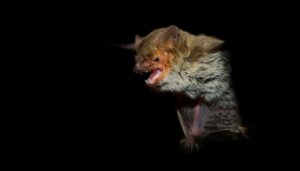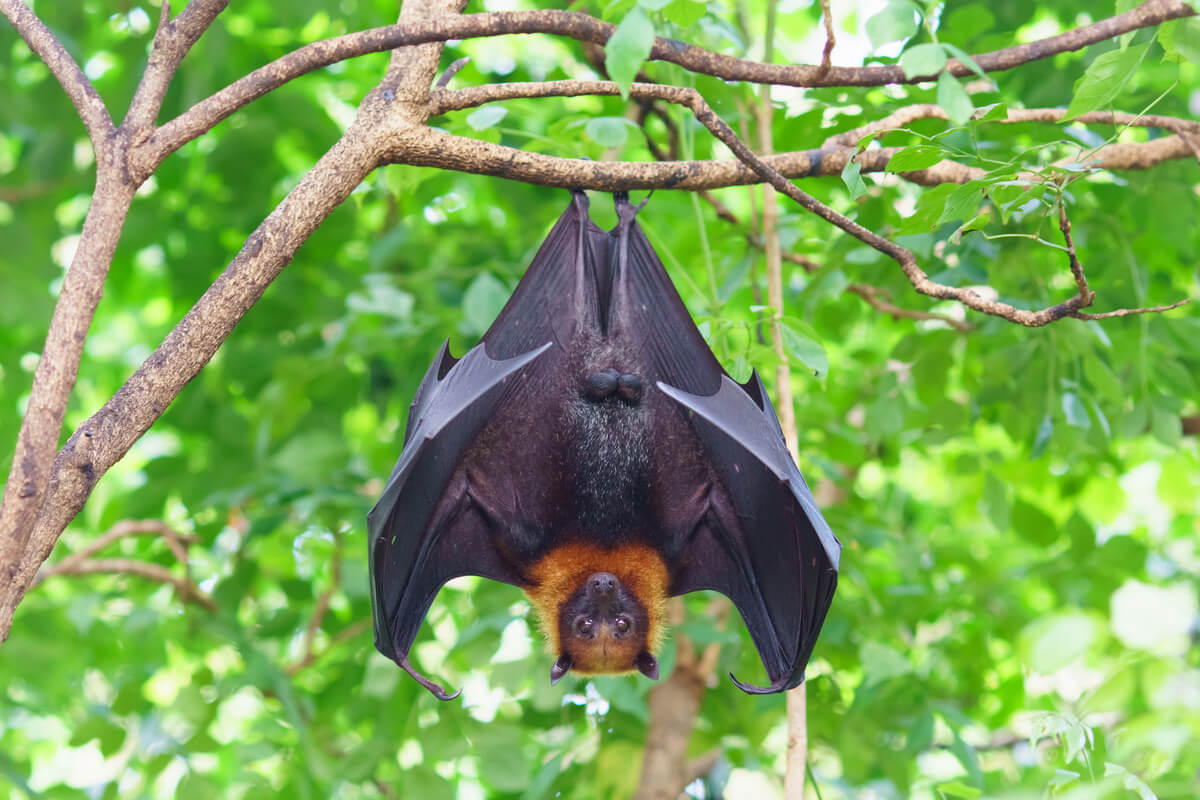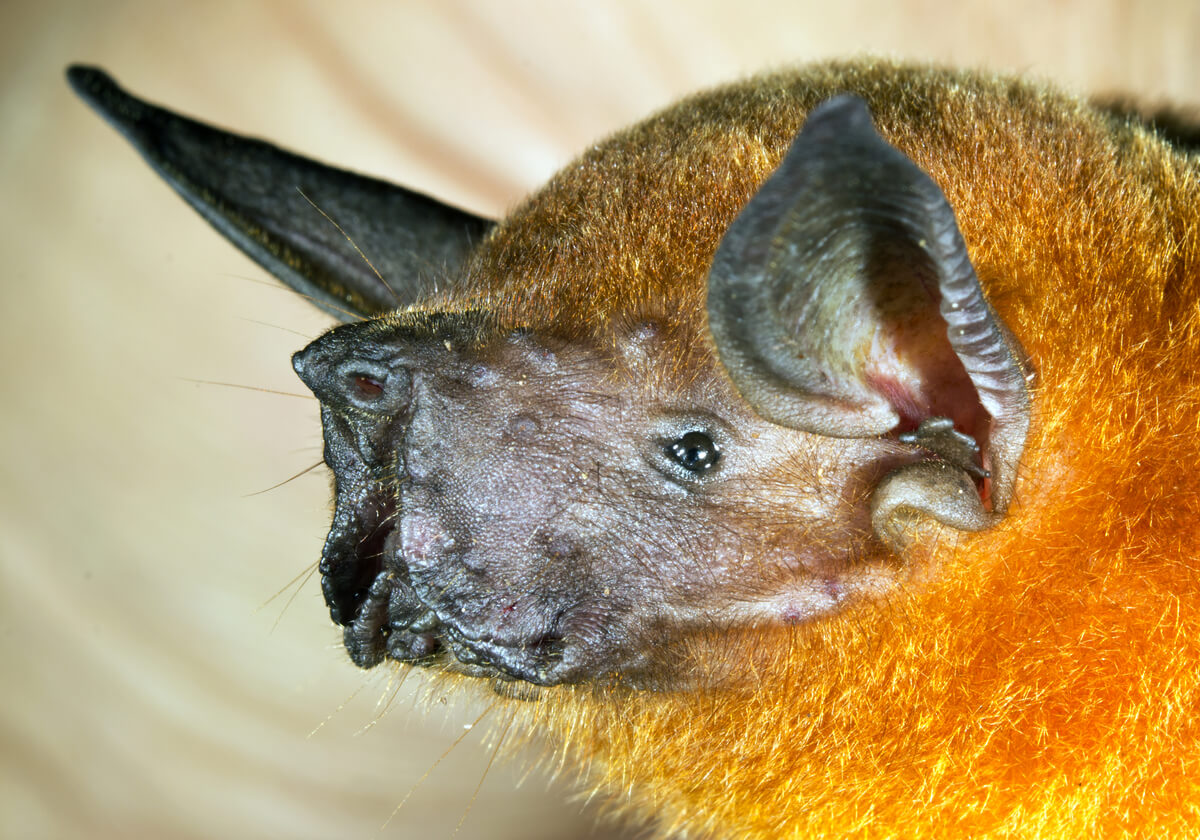Are Bats Blind?


Reviewed and approved by the biologist Samuel Sanchez
Many people believe that bats are blind or that they have extremely poor vision. This myth is based on their physical appearance, since many of them have small eyes, and also because they use echolocation to guide them.
However, we need to point out that having good ears doesn’t imply they have poor vision. It’s true that some of the bats’ senses are more important to them than their sight, but this varies in each species. If you’re someone who believes or has heard that bats are blind, read on and discover the truth!
Are bats blind and other myths
There are more than 1100 species of bats (Chiroptera), each of them with different characteristics. There are social bats and others that prefer solitude. Some are long-eared, others have tongues as long as their bodies, some are white and others are black or striped. They represent 20% of all living mammals, so such diversity is to be expected.
Apart from the myth that bats are blind, there are others that aren’t true either, such as that they bring bad luck, that they’re mice with wings, that they’re part of the bird family, or – much worse – that they’re pests. Bats are shrouded in cultural confusion, ever since the discovery of the vampire bat which represents but a small minority of this group.
The Pontificia Universidad Javeriana de Bogotá tells us that bats have been involved in different societies since ancient times. In the Mexican Zapotec culture, this winged mammal is the god of fertility; in the Mayan it represents sacrifices, and, in the Aztec, it’s associated with death.
Other cultures link the bat to the night, vampires, the underworld, and death. All this shows the lack of knowledge about their virtues and the important role these mammals play in the well-being of ecosystems. About 70% of the species are insectivorous and almost all the rest feed on fruits.
The importance of bats
The appearance of bats resembles that of ‘winged’ rodents such as flying squirrels. However, both animals have different anatomical structures and a very different evolutionary history, according to studies by the Humboldt Institute.
These mammals can live up to 44 years, they belong to the Chiroptera order, the second most abundant taxon of mammals in the world. The word chiropter comes from the Greek and means ‘hand wing’, because, according to experts, bats are able to fly thanks to their modified hands.
Some bats feed on fruits, dispersing the seeds that regenerate forests and battered areas. Others base their diet on insects, thus controlling crop pests, favoring the cotton, corn, bean, and rice industries, and reducing the population of pests, such as dengue or malaria.
There are also bats that feed on the nectar of flowers, which gives rise to the pollination of many plants. Some are carnivores, but of 1421 species identified today, only three feed on blood.

Are bats blind?
It’s believed that bats can’t see or that their visual ability is very poor. It’s true that bats have small eyes and, in some species, they aren’t well developed, but they aren’t blind and some even see quite well.
Fundación Con Vida says that bats that eat insects have advanced ears and a sound system, called echolocation. This serves to complement their vision and allows them to be active at night without any problem.
In addition, the fact that these mammals have good ears doesn’t mean that they’re blind, as they’re also more sensitive to be able to locate objects. In this way, they can move easily in the forest or in open areas and locate their food with precision.
Echolocation is a radar-like location system. These animals emit characteristic sounds, which bounce off objects and return as an echo to their ears and nervous system, to process the information.
Their vision varies
The scientific journal Molecular Biology and Evolution reports that bats possess some of the most unique and peculiar adaptations observed among mammals, which makes them excellent models for studying the evolution of sensory perception.
They’re successful nocturnal animals, the only mammals that can actually fly, and the only mammals of the group that use echolocation to hunt, avoid obstacles, and find their way in low light conditions.
This unique hearing ability shows great variation among the 21 families of echolocation bats. It has been argued that these species have developed this acoustic sense at the expense of their other senses, such as vision, given the typically small eye size of an echolocator bat.
However, this is not the case in all cases. For example, the Pteropodidae family of bats doesn’t use laryngeal echolocation, as they have large, sensitive eyes, specialized for night vision.
The sight of bats adjusts to low light conditions, such as those that occur during dawn and dusk. While some may not have as good color vision as humans, their general vision may be better than ours during sunrise and sunset, according to experts.
People with poor vision are often called “blind as a bat,” but the expression is inappropriate, as bats can see quite well, with an acuity that varies from species to species. This phrase perhaps originated from the fact that bats have fast and erratic flight patterns, resembling a person stumbling.
They aren’t blind, but some can’t see in color
Bats are famous for using their hearing to explore their environments, yet few people know that these flying mammals have good daytime and night vision.
Some bats can even see in color, thanks to two light-sensitive proteins on the back of their eyes. However – says the organization eLife – many species of bats only have one of these proteins and can’t distinguish colors at all.

Bats are wonderful and surprising species, full of myths and associations invented by humans. Treating them with respect, just like we should all animals, is essential in order to preserve the balance of the ecosystem.
Many people believe that bats are blind or that they have extremely poor vision. This myth is based on their physical appearance, since many of them have small eyes, and also because they use echolocation to guide them.
However, we need to point out that having good ears doesn’t imply they have poor vision. It’s true that some of the bats’ senses are more important to them than their sight, but this varies in each species. If you’re someone who believes or has heard that bats are blind, read on and discover the truth!
Are bats blind and other myths
There are more than 1100 species of bats (Chiroptera), each of them with different characteristics. There are social bats and others that prefer solitude. Some are long-eared, others have tongues as long as their bodies, some are white and others are black or striped. They represent 20% of all living mammals, so such diversity is to be expected.
Apart from the myth that bats are blind, there are others that aren’t true either, such as that they bring bad luck, that they’re mice with wings, that they’re part of the bird family, or – much worse – that they’re pests. Bats are shrouded in cultural confusion, ever since the discovery of the vampire bat which represents but a small minority of this group.
The Pontificia Universidad Javeriana de Bogotá tells us that bats have been involved in different societies since ancient times. In the Mexican Zapotec culture, this winged mammal is the god of fertility; in the Mayan it represents sacrifices, and, in the Aztec, it’s associated with death.
Other cultures link the bat to the night, vampires, the underworld, and death. All this shows the lack of knowledge about their virtues and the important role these mammals play in the well-being of ecosystems. About 70% of the species are insectivorous and almost all the rest feed on fruits.
The importance of bats
The appearance of bats resembles that of ‘winged’ rodents such as flying squirrels. However, both animals have different anatomical structures and a very different evolutionary history, according to studies by the Humboldt Institute.
These mammals can live up to 44 years, they belong to the Chiroptera order, the second most abundant taxon of mammals in the world. The word chiropter comes from the Greek and means ‘hand wing’, because, according to experts, bats are able to fly thanks to their modified hands.
Some bats feed on fruits, dispersing the seeds that regenerate forests and battered areas. Others base their diet on insects, thus controlling crop pests, favoring the cotton, corn, bean, and rice industries, and reducing the population of pests, such as dengue or malaria.
There are also bats that feed on the nectar of flowers, which gives rise to the pollination of many plants. Some are carnivores, but of 1421 species identified today, only three feed on blood.

Are bats blind?
It’s believed that bats can’t see or that their visual ability is very poor. It’s true that bats have small eyes and, in some species, they aren’t well developed, but they aren’t blind and some even see quite well.
Fundación Con Vida says that bats that eat insects have advanced ears and a sound system, called echolocation. This serves to complement their vision and allows them to be active at night without any problem.
In addition, the fact that these mammals have good ears doesn’t mean that they’re blind, as they’re also more sensitive to be able to locate objects. In this way, they can move easily in the forest or in open areas and locate their food with precision.
Echolocation is a radar-like location system. These animals emit characteristic sounds, which bounce off objects and return as an echo to their ears and nervous system, to process the information.
Their vision varies
The scientific journal Molecular Biology and Evolution reports that bats possess some of the most unique and peculiar adaptations observed among mammals, which makes them excellent models for studying the evolution of sensory perception.
They’re successful nocturnal animals, the only mammals that can actually fly, and the only mammals of the group that use echolocation to hunt, avoid obstacles, and find their way in low light conditions.
This unique hearing ability shows great variation among the 21 families of echolocation bats. It has been argued that these species have developed this acoustic sense at the expense of their other senses, such as vision, given the typically small eye size of an echolocator bat.
However, this is not the case in all cases. For example, the Pteropodidae family of bats doesn’t use laryngeal echolocation, as they have large, sensitive eyes, specialized for night vision.
The sight of bats adjusts to low light conditions, such as those that occur during dawn and dusk. While some may not have as good color vision as humans, their general vision may be better than ours during sunrise and sunset, according to experts.
People with poor vision are often called “blind as a bat,” but the expression is inappropriate, as bats can see quite well, with an acuity that varies from species to species. This phrase perhaps originated from the fact that bats have fast and erratic flight patterns, resembling a person stumbling.
They aren’t blind, but some can’t see in color
Bats are famous for using their hearing to explore their environments, yet few people know that these flying mammals have good daytime and night vision.
Some bats can even see in color, thanks to two light-sensitive proteins on the back of their eyes. However – says the organization eLife – many species of bats only have one of these proteins and can’t distinguish colors at all.

Bats are wonderful and surprising species, full of myths and associations invented by humans. Treating them with respect, just like we should all animals, is essential in order to preserve the balance of the ecosystem.
All cited sources were thoroughly reviewed by our team to ensure their quality, reliability, currency, and validity. The bibliography of this article was considered reliable and of academic or scientific accuracy.
Baird, C. (2013, 9 abril). Why are bats blind? Science Questions with Surprising Answers. https://wtamu.edu/%7Ecbaird/sq/2013/04/09/why-are-bats-blind/
eek! (s. f.). Datos de Murciélagos. Environmental Education for Kid. Recuperado 29 de mayo de 2021, de https://www.eekwi.org/es/animals/mammals/datos-de-murcielagos
Fog, L., & Guzmán, J. (2021, 12 abril). Los secretos de los murciélagos. Revista Pesquisa Javeriana. https://www.javeriana.edu.co/pesquisa/los-secretos-de-los-murcielagos/
García, L. (s. f.). ¿Aterradores o apasionantes?: Mitos y verdades sobre los murciélagos. Instituto de Investigación de Recursos Biológicos Alexander von Humboldt. Recuperado 27 de mayo de 2021, de http://www.humboldt.org.co/es/actualidad/item/1121-mitos-y-verdades-murcielagos
García, L. (2020, 8 abril). Cinco datos para espantar el temor a los murciélagos (y otros cinco para quererlos). Fundación Con Vida. https://fconvida.org/cinco-datos-para-espantar-el-temor-a-los-murcielagos-y-otros-cinco-para-quererlos/#:%7E:text=No%20son%20ciegos,capacidad%20visual%20es%20muy%20limitada
How bats lost their color vision. (2019, 15 enero). ELife. https://elifesciences.org/digests/37412/how-bats-lost-their-color-vision
Simões, B. F., Foley, N. M., Hughes, G. M., Zhao, H., Zhang, S., Rossiter, S. J., & Teeling, E. C. (2019). As Blind as a Bat? Opsin Phylogenetics Illuminates the Evolution of Color Vision in Bats. Molecular biology and evolution, 36(1), 54–68. https://doi.org/10.1093/molbev/msy192
This text is provided for informational purposes only and does not replace consultation with a professional. If in doubt, consult your specialist.








